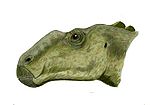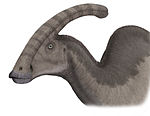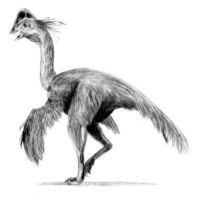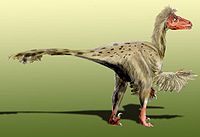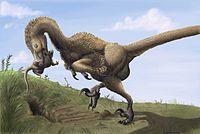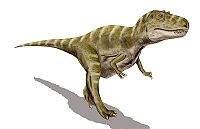- Dinosaur Park Formation
-
Dinosaur Park Formation
Stratigraphic range: Late Cretaceous, 76.5–75 Ma [1]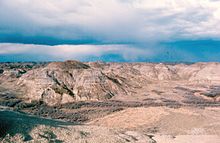
Dinosaur Park Formation exposed along the Red Deer River, Dinosaur Provincial Park, in southern Alberta.Type Geological formation Unit of Belly River Group Underlies Bearpaw Formation Overlies Oldman Formation Lithology Primary Sandstone (lower)
Siltstone (upper)Location Named for Dinosaur Provincial Park Named by Eberth, D.A. and Hambling, A.P., 1993[2] Region  Alberta
AlbertaCountry  Canada
CanadaThe Dinosaur Park Formation is the uppermost member of the Judith River Group, a major geologic unit in southern Alberta. It was laid down over a period of time between about 76.5 and 75 million years ago.[1] The formation is made up of deposits of a high-sinuosity (anastomosing) fluvial system, and is capped by the Lethbridge Coal Beds. The formation is bounded by the Oldman Formation below it and the marine Bearpaw Formation above it (Eberth, 2005).
It is known for the dense concentrations of dinosaur skeletons, both articulated and disarticulated, that are found there. However, other animals such as fish, turtles, and crocodilians are also abundant in the formation. The formation has been named after Dinosaur Provincial Park, a UNESCO World Heritage Site.
Contents
Biostratigraphy
The Dinosaur Park Formation can be divided into at least two distinct faunas. The lower part of the formation is characterized by the abundance of Corythosaurus and Centrosaurus. This group of species is replaced higher in the formation by a different ornithischian fauna characterized by the presence of Lambeosaurus and Styracosaurus. The appearance of several new, rare species of ornithischian at the very top of the formation may indicate that a third distinct fauna had replaced the second during the transition into younger, non-Dinosaur Park sediments, at the same time an inland sea transgresses onto land, but there are fewer remains here. An unnamed pachyrhinosaur, Vagaceratops irvinensis, and Lambeosaurus magnicristatus may be more common in this third fauna.[3][4]
The timeline below follows a synthesis presented by Arbour et al. 2009 with additional information from Evans et al. 2009

Amphibians (Gardner, 2005)
Albanerpetonidae (extinct, salamander-like amphibians)
Caudata (salamanders)
- Habrosaurus
- Lisserpeton
- Opisthotriton
- Scapherpeton
- unnamed caudatan
- 2 indeterminate caudatans
Salienta (frogs)
- 2 unnamed salientans
Dinosaurs
List of dinosaurs found in the formation:[1](Currie, 2005)
Ornithischians
(Ryan and Evans, 2005)
Ankylosaurs
Ankylosaurs reported from the Dinosaur Park Formation Genus Species Location Stratigraphic position Material Notes Images D. acutosquameus
Lower, 76.5Ma ago[1]
E. longiceps
Unit 2, Horseshoe Canyon Formation, 71-70.5Ma ago[1]
E. rugosidens
Lower, 76.5-75.9Ma ago[1]
E. tutus
Entire, 76.5-75Ma ago[1]
P. mirus
Middle, 75.6Ma ago[1]
"Partial skeleton with complete skull, osteoderms, additional isolated teeth, postcranial elements, osteoderms."[5]
Ceratopsians
An unnamed Pachyrhinosaurus-like taxon has been recovered from the formation.
Color key
Taxon Reclassified taxon Taxon falsely reported as present Discredited taxon Ichnotaxon Ootaxon Morphotaxon Notes
Uncertain or tentative data are in small text;crossed outdata are discredited.Ceratopsians reported from the Dinosaur Park Formation Genus Species Location Stratigraphic position Material Notes Images A. ornatus
Misidentified, actually a new genus and species[citation needed]
C. apertus
Middle, 76.2-75.5Ma ago[1]
"[Fifteen] skulls, several skeletons, all adult; abundant bone-bed material with rare juveniles and subadults."[6]
C. belli
Middle, 76-75.5Ma ago[1]
"[Twelve] skulls, several skeletons."[6]
C. irvinensis
Reclassified as Vagaceratops irvinensis[7]
C. russelli
Lower, 76.5-76Ma ago[1]
"[Six] complete or partial skulls."[8]
Indeterminate
M. lowei
S. albertensis
Upper, 75.5-75.2Ma ago[1]
"[Two] skulls, [three] skeletons, additional material in bone beds."[6]
V. irvinensis
Upper, 75Ma ago[1]
"[Three] skulls, skeleton lacking tail."[8]
"Almond Formation" ceratopsid
Unnamed
Upper Unit 1, Horseshoe Canyon Formation, 72.2-71Ma ago[1]
Misidentified as Anchiceratops, it is actually a new species, probably the same as a new Pentaceratops-like form from the Almond Formation of Wyoming[citation needed]
Ornithopods
At least one indeterminate hypsilophodont specimenhas been recovered from the formation.
In 2001 Darren H. Tanke and M. K. Brett-Surman reviewed and described eggshell and hatchling material from the Dinosaur Park Formation.[9] Eggshell is rare in the Park, being present in only two microfossil sites, both of which are predominated by the preserved shells of invertebrate life.[9] The survival of hadrosaur eggshell fragments in the presence of these invertebrate shells may be result of calcium in the invertebrate shells buffering contemporary acidic water which would have dissolved them.[9] The hadrosaur eggshell fragments "show little to no stream abrasion" suggesting that the material did not originate far from their final burial place in the Park.[9] The authors felt that their newly reported material corroborated the then-recent suggestion that hadrosaurs did not nest exclusively in upland areas, but also areas of lower elevation.[9] Some recovered hadrosaur fossils might actually be from embryos.[10] Hatchling and nestling-sized hadrosaur remains had been falsely considered rare in Dinosaur Park Formation due to bias on the part of collectors seeking larger specimens and sometimes not recognizing what was encountered.[10] Hadrosaurs had been speculated to be upland breeders due to the lack of preserved egg and hatchling material.[10] However young hadrosaur remains had been previously reported from lowland deposits.[10]
Darren Tanke observed that an experienced collector could actually discover multiple juvenile hadrosaur specimens a day.[10] During the 1992 field season a concerted effort was undertaken by the Royal Tyrell Museum to recover the remains of young hadrosaurs.[10] The researchers describe the acquisition that season of 43 specimens as being a success.[10] Most of the recovered fossils were of dentaries missing their teeth, bones from limbs and feet, as well as vertebral centra.[10] The material showed little or none of the abrasion that would have resulted from transport, meaning the fossils were buried near their point of origin.[10] The researchers conclude that this meant that hadrosaurs were nesting in the lowlands of the area represented by the strata containing the fossils and that previous workers hypotheses of lowland hadrosaur breeding were "confirmed."[10] Most of the shells from the microfossil site are from pisidiid clams, but rarely unionid clams and gastropods are found.[11] It was the slow dissolution of these shells releasing calcium carbonate into the water that raised the water's pH high enough to prevent the eggshells from dissolving.[11]
No fragment's greatest dimension exceeds one cm.[11] The eggshells' surface has a pebbly texture.[11] The eggshell is similar to the eggshells from the Two Medicine and Judith River Formations in Montana.[11] Dinosaur Provincial Park eggshell is similar to eggshell from the Devil's Coulee in southern Alberta.[11] Most hadrosaur neonate bones are incomplete due to their small size and vulnerability to the high erosion rates in the Dinosaur Provincial Park.[12] Dentaries are common hadrosaur neonate fossils.[12] Most specimens don't preserve all of the tooth replacement gooves.[12] Most preserve "only about [ten] tooth files."[12] No neural arches are represented among the vertebrae fossils.[13] Although some limb bones show signs of transport wear, the distances traveled before burial were probably not far as such small bones would be unlikely to survive the great diversity of scavengers and acidic water conditions.[14] Bonebeds 23, 28, 47, and 50 yielded "unusually high" numbers of young hadrosaur remains.[15] Certain outcrops of bonebed 50 are "particularly rich," producing around a dozen such fossils a year.[15] Dinosaur eggshell is lacking from the bone beds producing the hadrosaur juvenile bones.[15] Tanke concluded that the abundance of bone in these locations is not due to collecting biases or intensity.[15]
The authors concluded that hadrosaurs nested in both upland or lowland area, although described factors influencing the division of breeding locations as unknown.[16] They suggested that "diet, soil conditions, habits, [and] competition" between dinosaur genera might have played roles.[16] Some of the less common hadrosaurs in the Dinosaur Park Formation of Dinosaur Provincial Park like Parasaurolophus may represent the remains of individuals who died while migrating through the region.[16] They might also have had a more upland habitat where they may have nested or fed.[16]
Ornithopods reported from the Dinosaur Park Formation Genus Species Location Stratigraphic position Material Notes Images C. casuarius
Lower-Middle, 76.5-75.5Ma ago[1]
"Approximately [ten] articulated skulls and associated postcrania, [ten to fifteen] articulated skulls, isolated skull elements, juvenile to adult."[17]
G. incurvimanus
Middle, 76-75.5Ma ago[1]
"Single fully articulated skull and skeleton."[18]
G. notabilis
Lower, 76.2-76Ma ago[1]
"Approximately [ten] complete skulls, [twelve] fragmentary skulls, associated postcrania."[18]
L. lambei
Upper, 75.5-75Ma ago[1]
"Approximately [seven] articulated skulls with associated postcrania, [possibly ten] articulated skulls, isolated skull elements, juvenile to adult."[19]
L. magnicristatus
Upper/Bearpaw Formation, 74.8Ma ago[1]
"[Two] complete skulls, [one[ with associated, articulated postcrania."[19]
P. walkeri
Lower, 76.5-75.3Ma ago[4]
"Complete skull and postcranial skeleton."[19]
P. maximus
"[Twenty to twenty-five] individuals, including at least [seven] articulated skulls and associated postcrania."[18]
Pachycephalosaurs
Pachycephalosaurs reported from the Dinosaur Park Formation Genus Species Location Stratigraphic position Material Notes Images H. sternbergi
G. albertae
"Frontoparietal dome."[20]
O. browni
"Frontoparietal dome."[20]
(?juvenile Stegoceras)
S. breve
(?Prenocephale)
S. validum
Theropods
In the Dinosaur Park Formation, small theropods are rare due to the tendency of their thin-walled bones to be broken or poorly preserved.[21] Small bones of small theropods that were preyed upon by larger ones may have been swallowed whole and digested.[22] In this context, the discovery of a small theropod dinosaur with preserved tooth marks was especially valuable.[21] Possible indeterminate avimimid and therizinosaurid remains are known from the formation.
Ornithomimids
Color key
Taxon Reclassified taxon Taxon falsely reported as present Discredited taxon Ichnotaxon Ootaxon Morphotaxon Notes
Uncertain or tentative data are in small text;crossed outdata are discredited.Ornithomimids reported from the Dinosaur Park Formation Genus Species Location Stratigraphic position Material Notes Images D. brevitertius
Junior synonym of Ornithomimus edmontonicus
D. samuelli
Junior synonym of Ornithomimus edmontonicus
O. altus
Reclassified as Struthiomimus altus
O. edmontonicus
An ornithomimid
O. elegans
Reclassified as Chirostenotes elegans
O. samuelli
Junior synonym of O. edmontonicus
S. altus
type specimen
An ornithomimid
S. samuelli
Junior synonym of Ornithomimus edmontonicus
Oviraptorosaurs
Color key
Taxon Reclassified taxon Taxon falsely reported as present Discredited taxon Ichnotaxon Ootaxon Morphotaxon Notes
Uncertain or tentative data are in small text;crossed outdata are discredited.Oviraptorosaurs reported from the Dinosaur Park Formation Genus Species Location Stratigraphic position Material Notes Images Caenagnathus
C. collinsi
Junior synonym of Chirostenotes pergracilis
C. elegans
Several fragmentary specimens, type specimen
Caenagnathids
C. pergracilis
Several fragmentary specimens, type specimen
E. elegans
Reclassified as Chirostenotes elegans
Macrophalangia
M. canadensis
Junior synonym of Chirostenotes pergracilis
M. elegans
Reclassified as Chirostenotes elegans
Paravians
Color key
Taxon Reclassified taxon Taxon falsely reported as present Discredited taxon Ichnotaxon Ootaxon Morphotaxon Notes
Uncertain or tentative data are in small text;crossed outdata are discredited.Paravians reported from the Dinosaur Park Formation Genus Species Location Stratigraphic position Material Notes Images Indeterminate
A possible hesperornithine bird
Indeterminate
Partial coracoid
A possible charadriiform bird
D. albertensis
Several specimens and teeth, type specimen
A dromaeosaurid, also found in the Judith River, Mesaverde, and Prince Creek Formations
Hesperonychus
H. elizabethae
Hip bones and partial toes and claws, type specimen
A dromaeosaurid, also found in the Oldman Formation
Unnamed
Partial shoulder girdles
A possible galliform bird, also found in the Foremost Formation
P. lacustris
Teeth
An indeterminate maniraptoran, also found in the Judith River, Milk River, Frenchman, Horseshoe Canyon, Scollard, and Lance and Kirtland Formations
R. gilmorei
Teeth, type specimen
A dromaeosaurid, also found in the Horseshoe Canyon, Judith River and Aguja Formations.
S. langstoni
Incomplete skeleton and teeth, type specimen. A dentary referred to Saurornitholestes was discovered that preserved tooth marks left by a young tyrannosaur.[23]
A dromaeosaurid
Stenonychosaurus
S. inequalis
Junior synonym of Troodon inequalis
T. formosus
Partial skeletons
A troodontid, also found in the Oldman, Judith River, Lance, and Two Medicine Formations
T. inequalis
Nearly complete skeleton, type specimen
A troodontid
Tyrannosaurs
Color key
Taxon Reclassified taxon Taxon falsely reported as present Discredited taxon Ichnotaxon Ootaxon Morphotaxon Notes
Uncertain or tentative data are in small text;crossed outdata are discredited.Tyrannosaurs reported from the Dinosaur Park Formation Genus Species Location Stratigraphic position Material Notes Images A. libratus
Reclassified as Gorgosaurus libratus
A. sternbergi
Junior synonym of Gorgosaurus libratus
Unnamed species
Middle-Upper, 75.6-75Ma ago[1]
Several specimens
A tryannosaurid, also present in the Bearpaw Formation
D. libratus
Reclassified as Gorgosaurus libratus
D. sternbergi
Junior synonym of Gorgosaurus libratus
G. libratus
Lower-Middle, 76.6-75.1Ma ago[1]
Numerous specimens, type specimen
A tyrannosaurid, also present in the Judith River and Oldman Formations
G. sternbergi
Junior synonym of G. libratus
Fish
Chondrichthyans (Neuman and Brinkman, 2005)
Acipenseriformes (sturgeons) (Neuman and Brinkman, 2005)
- unnamed sturgeon
- unnamed paddlefish
Holostean fish (Neuman and Brinkman, 2005)
- Belonostomus
- Lepisosteus (the gar)
- unnamed bowfin
- at least 2 other holosteans
Teleost fish (Neuman and Brinkman, 2005)
- Patatarpon (an elopomorph, like the tarpon)
- Cretophareodus (an osteoglossomorph)
- Coriops
- Estesesox
- Oldmanesox
- Paralbula (including Phyllodus)
- at least 8 other teleosts
Invertebrates (Johnston and Hendy, 2005)
Freshwater bivalves
- Fusconaia
- Lampsilis
- Sphaerium (2 species)
Freshwater gastropods
- Campeloma (2 species)
- Elimia
- Goniobasis (3 species)
- Hydrobia
- Lioplacodes (2 species)
Mammals (Fox, 2005)
- Cimexomys sp.
- Cimolodon spp.
- Cimolomys clarki
- Meniscoessus major
- Mesodma primaeva
- unnamed multituberculates
- Alphadon halleyi
- Eodelphis browni
- E. cutleri
- 5 species of "Pediomys"
- Turgidodon russelli
- T. praesagus
Placentals
- Cimolestes sp. (uncertain taxonomy)
- Gypsonictops lewisi
- Paranyctoides sternbergi
Unknown therians: at least 1 species
Plants
Plant body fossils (Koppelhus, 2005)
- various ferns
- Equisetum (Equisetaceae)
- Platyspiroxylon (Cupressaceae)
- Podocarpoxylon (Podocarpaceae)
- Elatocladus (Taxodiaceae)
- Sequoia (Taxodiaceae)
- Sequoiaxylon (Taxodiaceae)
- Taxodioxylon (Taxodiaceae)
- Baeria
- Ginkgoites
Angiosperms
- Artocarpus (Moraceae)
- Cercidiphyllum (Cercidiphyllaceae)
- Dombeyopsis (Sterculiaceae)
- Menispermites (Menispermaceae)
- Pistia (Araceae)
- Platanus (Platanaceae)
- Vitis (Vitaceae)
- Trapa (Trapaceae)
Palynomorphs
Palynomorphs are organic-walled microfossils, like spores, pollen, and algae (Braman and Koppelhus, 2005) Unknown producers
- at least 8 species
Fungi
- at least 35 taxa
Chlorophyta (green algae and blue-green algae)
- at least 12 species
Pyrrhophyta (dinoflagellates, a type of marine algae)
- unassigned cysts
Bryophytes (mosses, liverworts, and hornworts)
- Anthocerotophyta (hornworts)
- at least 5 species
- Marchantiophyta (liverworts)
- at least 14 species
- Bryophyta (mosses)
- at least 5 species
- Lycopodiaceae (club mosses)
- at least 11 species
- Selaginellaceae (small club mosses)
- at least 6 species
- Isoetaceae (quillworts)
- at least 1 species
Polypodiophyta
- Osmundaceae (cinnamon ferns)
- at least 6 species
- Schizaeaceae (climbing ferns)
- at least 20 species
- Gleicheniaceae (Gleichenia and allies; coral ferns)
- at least 5 species
- Cyatheaceae (Cyathea and allies)
- at least 4 species
- Dicksoniaceae (Dicksonia and allies)
- at least 3 species
- Polypodiaceae (ferns)
- at least 4 species
- Matoniaceae
- at least 1 species
- Marsileaceae
- at least 1 species
- Cycadaceae (cycads)
- at least 3 species
- Caytoniaceae
- at least 1 species
- Pinaceae (pines)
- at least 4 species
- Cupressaceae (cypresses)
- at least 3 species
- Podocarpaceae (Podocarpus and allies)
- at least 4 species
- Cheirolepidiaceae
- at least 2 species
- Ephedraceae (Mormon teas)
- at least 6 species
Unknown gymnosperms: at least 3 species
Magnoliophyta (angiosperms)
- Magnoliopsida (dicots)
- Buxaceae (boxwood)
- at least 1 species
- Gunneraceae (gunneras)
- at least 1 species
- Salicaceae (willows, cottonwood, quaking aspen)
- at least 1 species
- Droseraceae (sundews)
- at least 1 species
- Olacaceae (tallowwood)
- at least 2 species
- Loranthaceae (showy mistletoes)
- at least 1 species
- Sapindaceae (soapberry)
- at least 1 species
- Aceraceae (maples)
- at least 1 species
- Proteaceae (proteas)
- at least 9 species
- Compositae (sunflowers)
- at least 1 species
- Fagaceae (beeches, oaks, chestnuts)
- at least 2 species
- Betulaceae (birches, alders)
- at least 1 species
- Ulmaceae (elms)
- at least 1 species
- Chenopodiaceae (goosefoots)
- at least 1 species
- Buxaceae (boxwood)
- Liliopsida (monocots)
- Liliaceae (lilies)
- at least 6 species
- Cyperaceae (sedges)
- at least 1 species
- Sparganiaceae (bur-reeds)
- possibly 1 species
- Liliaceae (lilies)
- Unknown angiosperms: at least 88 species
Other reptiles
Choristoderes
Choristoderes, or champsosaurs, were aquatic reptiles. Small examples looked like lizards, while larger types were superficially similar to crocodilians (Keqin Gao and Brinkman, 2005)
- Champsosaurus (at least 3 species)
- Cteniogenys
Crocodylians (Xiao-Chun Wu, 2005)
- Albertochampsa
- Leidyosuchus
- at least 1 unnamed taxon
Lizards (Caldwell, 2005)
Helodermatids
- Labrodioctes
Necrosaurids
- Parasaniwa
- Glyptogenys
- Socognathus
Varanids
- ?Exostinus
Plesiosaurs (Sato, Eberth, Nicholls, and Manabe, 2005)
- indeterminate elasmosaurids (very long-necked) (more common)
- indeterminate polycotylids (shorter-necked)
Pterosaurs (Godfrey and Currie, 2005)
- Navajodactylus[24]
- 1 large unnamed azhdarchid (giant, long-necked pterosaur)
- 1 smaller unnamed azhdarchid
- 1 unnamed non-azhdarchid pterosaur
Turtles (Brinkman, 2005)
- Adocus
- "Apalone"
- Aspideretoides (3 species)
- Basilemys
- Boremys
- Judithemys
- Neurankylus
- Plesiobaena
- 2 indeterminate taxa
See also
Footnotes
- ^ a b c d e f g h i j k l m n o p q r s t u Arbour, et al. (2009).
- ^ Lexicon of Canadian Geologic Units: Dinosaur Park Formation
- ^ Ryan and Evans (2005).
- ^ a b Evans D.C., Bavington R., Campione N.E. (2009). "An unusual hadrosaurid braincase from the Dinosaur Park Formation and the biostratigraphy of Parasaurolophus (Ornithischia: Lambeosaurinae) from southern Alberta". Canadian Journal of Earth Sciences 46 (11): 791–800. doi:10.1139/E09-050. http://www.freepatentsonline.com/article/Canadian-Journal-Earth-Sciences/215925510.html.
- ^ "Table 17.1," in Weishampel, et al. (2004). Page 365.
- ^ a b c "Table 23.1," in Weishampel, et al. (2004). Page 495.
- ^ Scott D. Sampson, Mark A. Loewen, Andrew A. Farke, Eric M. Roberts, Catherine A. Forster, Joshua A. Smith, Alan L. Titus (2010). "New Horned Dinosaurs from Utah Provide Evidence for Intracontinental Dinosaur Endemism". PLoS ONE 5 (9): e12292. doi:10.1371/journal.pone.0012292. PMC 2929175. PMID 20877459. http://www.plosone.org/article/info%3Adoi%2F10.1371%2Fjournal.pone.0012292.
- ^ a b "Table 23.1," in Weishampel, et al. (2004). Page 496.
- ^ a b c d e "Abstract," Tanke and Brett-Surman (2001). Page 206.
- ^ a b c d e f g h i j "Introduction," Tanke and Brett-Surman (2001). Page 208.
- ^ a b c d e f "Eggshell," Tanke and Brett-Surman (2001). Page 209.
- ^ a b c d "Bones," Tanke and Brett-Surman (2001). Page 209.
- ^ "Bones," Tanke and Brett-Surman (2001). Page 211.
- ^ "Discussion," Tanke and Brett-Surman (2001). Pages 211-212.
- ^ a b c d "Discussion," Tanke and Brett-Surman (2001). Page 212.
- ^ a b c d "Conclusions," Tanke and Brett-Surman (2001). Page 212.
- ^ "Table 20.1," in Weishampel, et al. (2004). Page 441.
- ^ a b c "Table 20.1," in Weishampel, et al. (2004). Page 440.
- ^ a b c "Table 20.1," in Weishampel, et al. (2004). Page 442.
- ^ a b "Table 21.1," in Weishampel, et al. (2004). Page 465.
- ^ a b "Introduction," Jacobsen (2001). Page 59.
- ^ "Discussion," Jacobsen (2001). Page 61.
- ^ "Abstract," Jacobsen (2001). Page 58.
References
- Arbour, V. M.; Burns, M. E.; and Sissons, R. L. (2009). "A redescription of the ankylosaurid dinosaur Dyoplosaurus acutosquameus Parks, 1924 (Ornithischia: Ankylosauria) and a revision of the genus". Journal of Vertebrate Paleontology 29 (4): 1117–1135. doi:10.1671/039.029.0405.
- Braman, D.R., and Koppelhus, E.B. 2005. Campanian palynomorphs. In: Currie, P.J., and Koppelhus, E.B. (eds), Dinosaur Provincial Park: A Spectacular Ancient Ecosystem Revealed. Indiana University Press: Bloomington and Indianapolis, 101-130.
- Brinkman, D.B. 2005. Turtles: diversity, paleoecology, and distribution. In: Currie, P.J., and Koppelhus, E.B. (eds), Dinosaur Provincial Park: A Spectacular Ancient Ecosystem Revealed. Indiana University Press: Bloomington and Indianapolis, 202-220.
- Caldwell, M.W. The squamates: origins, phylogeny, and paleoecology. In: Currie, P.J., and Koppelhus, E.B. (eds). 2005. ‘’Dinosaur Provincial Park: A Spectacular Ancient Ecosystem Revealed.’’ Indiana University Press: Bloomington and Indianapolis, 235-248.
- Currie, P.J. 2005. Theropods, including birds. In: Currie, P.J., and Koppelhus, E.B. (eds), Dinosaur Provincial Park: A Spectacular Ancient Ecosystem Revealed. Indiana University Press: Bloomington and Indianapolis, 367-397.
- Currie, P.J., and Koppelhus, E.B. (eds). 2005. Dinosaur Provincial Park: A Spectacular Ancient Ecosystem Revealed. Indiana University Press: Bloomington and Indianapolis, 648 p.
- Eberth, D.A. 2005. The geology. In: Currie, P.J., and Koppelhus, E.B. (eds), Dinosaur Provincial Park: A Spectacular Ancient Ecosystem Revealed. Indiana University Press: Bloomington and Indianapolis, 54-82.
- Fox, R.C. 2005. Late Cretaceous mammals. In: Currie, P.J., and Koppelhus, E.B. (eds), Dinosaur Provincial Park: A Spectacular Ancient Ecosystem Revealed. Indiana University Press: Bloomington and Indianapolis, 417-435.
- K. Gao and Brinkman, D.B. 2005. Choristoderes from the Park and its vicinity. In: Currie, P.J., and Koppelhus, E.B. (eds), Dinosaur Provincial Park: A Spectacular Ancient Ecosystem Revealed. Indiana University Press: Bloomington and Indianapolis, 221-234.
- Gardner, J.D. 2005. Lissamphibians. In: Currie, P.J., and Koppelhus, E.B. (eds), Dinosaur Provincial Park: A Spectacular Ancient Ecosystem Revealed. Indiana University Press: Bloomington and Indianapolis, 186-201.
- Godfrey, S.J., and Currie, P.J. 2005. Pterosaurs. In: Currie, P.J., and Koppelhus, E.B. (eds), Dinosaur Provincial Park: A Spectacular Ancient Ecosystem Revealed. Indiana University Press: Bloomington and Indianapolis, 292-311.
- Johnston, P.A., and Hendy, A.J.W. 2005. Paleoecology of mollusks from the Upper Cretaceous Belly River Group. In: Currie, P.J., and Koppelhus, E.B. (eds), Dinosaur Provincial Park: A Spectacular Ancient Ecosystem Revealed. Indiana University Press: Bloomington and Indianapolis, 139-166.
- Koppelhus, E.B. 2005. Paleobotany. In: Currie, P.J., and Koppelhus, E.B. (eds), Dinosaur Provincial Park: A Spectacular Ancient Ecosystem Revealed. Indiana University Press: Bloomington and Indianapolis, 131-138.
- Lexicon of Canadian Geologic Units. "Dinosaur Park Formation". http://cgkn1.cgkn.net/weblex/weblex_litho_detail_e.pl?00053:004018. Retrieved 2011-03-29.
- Neuman, A.G., and Brinkman, D.B. 2005. Fishes of the fluvial beds. In: Currie, P.J., and Koppelhus, E.B. (eds), Dinosaur Provincial Park: A Spectacular Ancient Ecosystem Revealed. Indiana University Press: Bloomington and Indianapolis, 167-185.
- Ryan, M.J., and Evans, D.C. 2005. Ornithischian dinosaurs. In: Currie, P.J., and Koppelhus, E.B. (eds), Dinosaur Provincial Park: A Spectacular Ancient Ecosystem Revealed. Indiana University Press: Bloomington and Indianapolis, 312-348.
- Sato, T., Eberth, D.A., Nicholls, E.L., and Manabe, M. 2005. Plesiosaurian remains from non-marine to paralic sediments. In: Currie, P.J., and Koppelhus, E.B. (eds), Dinosaur Provincial Park: A Spectacular Ancient Ecosystem Revealed.’’ Indiana University Press: Bloomington and Indianapolis, 249-276.
- Tanke, D.H. and Brett-Surman, M.K. 2001. Evidence of Hatchling and Nestling-Size Hadrosaurs (Reptilia:Ornithischia) from Dinosaur Provincial Park (Dinosaur Park Formation: Campanian), Alberta, Canada. pp. 206-218. In: Mesozoic Vertebrate Life—New Research Inspired by the Paleontology of Philip J. Currie. Edited by D.H. Tanke and K. Carpenter. Indiana University Press: Bloomington. xviii + 577 pp.
- Xiao-Chun Wu. 2005. Crocodylians. In: Currie, P.J., and Koppelhus, E.B. (eds), Dinosaur Provincial Park: A Spectacular Ancient Ecosystem Revealed. Indiana University Press: Bloomington and Indianapolis, 277-291.
Western Canadian Sedimentary Basin Hydrocarbon history Depositional Regions Southern Alberta · Central Alberta · Northwestern Alberta Plains · South-central Canadian Rockies foothills · North-east Plains · North-central foothills · Liard River · Fort Nelson · Northern Rocky Mountains · Fort St. John · Saskatchewan · Western ManitobaSouthern Alberta Plains Cypress Hills FM · Porcupine Hills FM · Ravenscrag FM · Edmonton GRP · Belly River GRP · Oldman FM · Foremost FM · Pakowki FM · Milk River FM · Colorado GRP · Mannville GRP · Ellis GRP (Swift FM · Rierdon FM · Sawtooth FM) · Rundle GRP · Banff FM · Exshaw FM · Bakken FM · Wabamun FM · Crowfoot FM · Nisku FM · Ireton FM · Leduc FM · Cooking Lake FM · Beaverhill Lake GRP · Elk Point GRP · Canadian ShieldCategories:- Natural history of Canada
- Stratigraphy of Alberta
Wikimedia Foundation. 2010.

